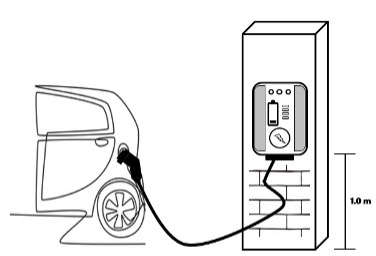
On February 14, 2024, the Energy Regulatory Commission (“CRE”) published on the National Commission for Regulatory Improvement (“CONAMER”) website the draft by which the CRE issues the General Administrative Provisions regarding Electromobility for the integration of Electric Vehicles and Connectable Hybrid Electric Vehicles charging infrastructure into the National Electric System as part of a Smart Grid (the “DACGs”). Currently, the DACGs are undergoing Regulatory Impact Analysis (“RIA”) before CONAMER, and the public will be able to comment on them.
To provide a general overview of the DACGs, we have prepared a summary of the most relevant content at the following:
- Purpose
The DACGs will regulate the orderly connection of charging infrastructure for Electric Vehicles (“EV”) and Connectable Hybrid Electric Vehicles (“CHEV”) safely to the National Electric System (“NES”) and the development of a digital platform to track the evolution of charging infrastructure in Mexico. This will be achieved through the following specific purposes:
- Establishing the general requirements for stakeholders intending to integrate EV and CHEV charging infrastructure into the NES.
- Promoting the participation of qualified personnel in the installation and connection of equipment dedicated to EV and CHEV charging, which will receive power supply from the NES.
- Establishing the information to be provided by End Users and Suppliers to integrate a relevant public information system (Platform) on EV and CHEV charging infrastructure.
- Scope
The DACGs are of public order, general interest, and enforceability throughout the Mexican territory. Compliance will be mandatory for the National Center of Energy Control (“CENACE”), Distributors (CFE Distribution), Suppliers, and End Users for the integration of EV and CHEV charging infrastructure into the NES.
- Request for Electricity Supply Service and Connection of EV and CHEV Charging Infrastructure
End Users wishing to install EV and CHEV charging infrastructure in a property already receiving Basic Supply Service at low or medium voltage must request a new electricity service contract independent of the electricity supply service they receive.
Suppliers shall verify that End Users requiring the infrastructure referred to in the preceding paragraph include the following in their file:
- Evidence of certification of Intelligent Electric Vehicle Chargers or Connectable Hybrid Electric Vehicle Chargers (“CHEVC”), receptacles and connectors in accordance with Mexican regulations or specified international standards;
- Documentation demonstrating compliance with cybersecurity specifications according to the current Grid Code regulations and ISO 15118-2:2019 standard;
- Proof that the electrical installation from the CHEVC to the connection point with the General Distribution Grid (“GDG”) is carried out by qualified personnel under Competency Standards EC0118 or EC1023;
- If applicable, a copy of the favorable Verification Opinion issued by an Electrical Installation Verification Unit stating that the electrical installation complies with NOM-001-SEDE-2012;
- If applicable, a certificate issued by an Inspection Unit certifying that the connection point infrastructure complies with the Grid Code regulations and technical specifications determined by the Distributor or CENACE;
- Evidence that the CHEVC has advanced functions of communication, control, and management of electricity; and
- Infrastructure Characteristics Form for EV and CHEV charging contained in Appendix 1 of the DACGs, filed with additional or complementary information as requested.
The process of connecting infrastructure intended for EV and CHEV charging depends on the voltage. For voltage equal to or greater than 69 kV, End Users shall submit their connection request to CENACE. For voltages lower than 69 kV, connection requests shall be handled by the Distributor.
- Assembly and Risk Signaling
Mode 2 CHEVC, intended to be wall-mounted but user-disassembleable or used in a shock-resistant casing, will utilize protective equipment according to the relevant NOM or current IEC 62752 standard.
Mode 3 EV charging infrastructure shall provide a protective ground conductor to the EV or CHEV power outlet and/or connector.
Mode 4 EV charging infrastructure may be permanently connected or via a cable and plugged into the power supply network. It shall have a ground conductor or connector protection for the vehicle.
For the installation of EV charging infrastructure near fuel dispensing areas, specifications of the Official Mexican Standard NOM-005-ASEA-2016 and other applicable regulations shall be followed, stipulating a minimum distance of 15 meters between the fuel dispensing area and public gathering places, the Mass Transit System, or any other electrified transportation system.
Source: Energy Regulatory Commission.
Wall-mounted EV charging infrastructure shall be installed at a minimum distance of one meter from the ground to prevent risks of electrocution of unqualified personnel or wildlife, as well as potential flooding.

Source: Energy Regulatory Commission
Electro-stations, Electro-terminals, or Public Charging Stations shall comply with the civil protection signage required by NOM-003-SEGOB-2011.
- Electro-stations, Electro-terminals, and Public Charging Stations
CHEVC installed in Electro-stations shall be of the charging station type, featuring at least a fast or ultra-fast charging mode to allow EV and CHEV users to charge their vehicles quickly.
Electro-stations are required to prominently display information about compatible connector types, charger types, charging modes, usage instructions, and, if possible, estimated charging time for each CHEVC. Until the CRE issues specific regulations on Demand Response, VE and CHEV will not be allowed to inject electricity into the GDG. Therefore, the communication and control functions of the CHEVC to interact bidirectionally with the NES will only be enabled when the Distributor or CENACE determines so in the connection studies.
Electro-stations shall have charging infrastructure compatible with at least two types of connectors available in the country (described in Table 1) and have CHEVC that allows charging for last-mile VE and CHEV.
Table 1 Connector Models for Charging VE and VEHC
|
Region |
North America |
Europe |
Asia |
||
|
Standard |
SAE |
NACS |
IEC |
CHAdeMO |
GB/T |
|
CA |
AC J1772 (Type 1) |
Teslaa |
62196-2 (Type 2 or Mennekes) |
J1772 |
20234.2 |
|
CC |
J1772
|
Teslaa |
62196-3 |
CHAdeMO |
20234.3 |
|
CCS1 |
CCS2 |
||||
a The VE manufacturer Tesla is a precursor of NACS, commercially known as the “Tesla” connector. |
|||||
|
SAE Society of Automotive Engineers. NACS North American Charging Standard. IEC International Electromechanical Commission. CHAdeMO Association of Electric Vehicle Manufacturers, same name as the Direct Current charger protocol. GB/T National Standards of the People's Republic of China. The T indicates it is a recommendation. |
|||||
Source: Energy Regulatory Commission |
|||||
Electro-stations shall visibly display prices for electricity intended for charging VE and VEHC, following these guidelines:
- Prices shall be displayed on price boards and labels.
- They shall be expressed in pesos per kilowatt/hour ($/kWh).
- They shall align with the prices reported to the CRE according to applicable legal provisions.
Price boards should be placed at Electro-stations complying with specific specifications, as well as price labels on the CHEVC.
End Users owning an Electro-station shall comply with federal, state, and municipal legal provisions regarding urban development and land use planning, for the preservation of cultural heritage and other applicable regulations.
Likewise, End Users engaging in the sale of energy at Electro-stations shall adhere to the provisions set forth in Decree No. A/039/2018, which issues the interpretation criterion of Article 46, fraction I of the Electricity Industry Law, regarding the sale of electricity from an End User to a third party (A/039/2018), or any modifications or replacements thereof, and submit their notice of energy sale within six months after receiving the electricity supply service.
- Battery Exchange Stations
Compliance with the specifications established in the corresponding Official Mexican Standard or NMX-J-785-1-ANCE-2020 and NMX-J-785-2-ANCE-2020 is required for battery exchange stations.
Likewise, End Users installing this type of station shall comply with the provisions of the General Law for the Prevention and Comprehensive Management of Waste in force, as well as those established in Official Mexican Standard NOM-052-SEMARNAT-2005, and other applicable regulations.
- Evolution and Monitoring of EV and EVHC Charging Infrastructure
End Users contracting the electricity supply service for EV and EVHC charging infrastructure shall attach to their electricity supply service request the information referred to in Appendix 1 of the DACGs. Owners of Electro-stations shall submit and update to the CRE Appendix 2 “Report updating of electricity prices in Electro-stations” of the DACGs preferably through the electromobility platform developed and operated by the CRE. While this platform is available, official communication channels of the CRE, such as email, or Filling Office, or Electronic Filling Office, may be used.
Suppliers shall submit quarterly reports to the CRE and CENACE on the number of electricity supply service requests dedicated to charging EV and EVHC filled and addressed. These reports shall include specific specifications for residential services identified in low voltage and for Electro-stations and Electro-terminals. The information provided will be the basis upon which the CRE will publish semi-annual statistics on the evolution of installed charging infrastructure in the country.
Additionally, the CRE will publish information regarding Electro-stations, such as their geo-references, charging infrastructure characteristics, and electricity prices through the electromobility platform.
- Surveillance
When necessary, the CRE may request information from End Users to review the installation conditions of Electro-stations or Electro-terminals. Additionally, the CRE may schedule and conduct verification visits to monitor compliance with the Grid Code regulations, the DACGs, and other applicable regulations. Verification visits may also be conducted on Suppliers and the Distributor to monitor compliance with the DACGs.
- Responsibilities and Obligations
a. End User
- Submit to the Supplier the Electricity Supply Service Request with the documentation required by the DACGs and follow up on the process.
- Install, maintain, and operate their Load Center dedicated to the charging of EV and EVHC, to ensure compliance with Efficiency, Quality, Reliability, Continuity, Safety, and Sustainability criteria.
- Submit to the Supplier compliance certificates or verification reports, as appropriate, for the execution of the Connection Contract to the GDG.
- Enter into the Connection Contract with the Distributor or CENACE.
- Hire certified personnel for the installation of the Load Center dedicated to the charging of EV and EVHC.
- Update the electricity price, through the communication means established by the CRE.
b. Supplier
- Receive, address, and follow up on supply requests for Load Centers dedicated to the charging of EV and EVHC.
- Maintain the confidentiality of the connection requests information, sharing it only with Distributors, CENACE, Ministry of Energy, CRE, or by court order.
- Provide the requested information to the CRE and CENACE.
c. Distributor
- Do not share information about connection requests of Load Centers dedicated to the charging of EV and EVHC with other industry agents.
- Address connection requests according to the current regulatory framework.
d. CENACE
- Address connection requests according to the current regulatory framework.
Finally, it is important to mention that the DACGs will apply to service requests for electricity supply and connection of Load Centers submitted from their effective date.
Likewise, it is established that the CRE will have the power to issue DACGs that include guidelines or tariff designs that promote the efficient development of Electro-stations.
The issuance of specific environmental and sustainability regulations is still pending. The Environment and Natural Resources Ministry will be accountable for issuing the applicable provisions regarding:
(i) Environmental impact: Will it be assessed through a preventive report, an environmental impact manifestation, or an impact exemption? Will such authorization be granted by the federal government due to the sector to which it belongs, or by local authorities, depending on the location and type of station (residential/commercial)?
(ii) Waste management: Will a differentiated character and management be given to these types of waste, or will their jurisdiction be determined according to their hazardous characteristics?
(iii) Atmospheric emissions: Will they be considered as fixed sources under federal or local jurisdiction?
(iv) Incentives: Will there be environmental incentives for contributing to actions that comply with Mexico's international commitments to reduce greenhouse gas emissions?
Although these rules represent a significant step forward for the electromobility sector, there is still a regulatory backlog related to environmental matters. This must be addressed by the authorities as soon as possible to avoid creating doubts, risks, and major challenges for the sector. Establishing fixed parameters will allow for swift progress towards electromobility. s
At Sánchez Devanny, we understand the importance of having regulations on electromobility. Therefore, we will keep you informed promptly about the AIR process, and if applicable, about the date the DACGs are published in the Official Gazette of the Federation and when they come into force.
This content was prepared by José Antonio Postigo-Uribe ([email protected]), Georgina Gutiérrez-Barbosa ([email protected]), Max Ernesto Hernández-Ernult ([email protected]), Tania Elizabeth Trejo-Galvez ([email protected]), José Enrique Cruz-Lozano ([email protected]), and Jesus Alonzo González-Hermosillo ([email protected]).
-
 February 25, 2025Initiative for a new Federal Antitrust and Economic Competition Law is submittedRead Newsletter
February 25, 2025Initiative for a new Federal Antitrust and Economic Competition Law is submittedRead Newsletter -
 February 12, 2025New legal regime for the energy sector in MexicoRead Newsletter
February 12, 2025New legal regime for the energy sector in MexicoRead Newsletter -
 February 11, 2025Strengthening and Expansion of the National Electric System Program (2025-2030)Read Newsletter
February 11, 2025Strengthening and Expansion of the National Electric System Program (2025-2030)Read Newsletter
